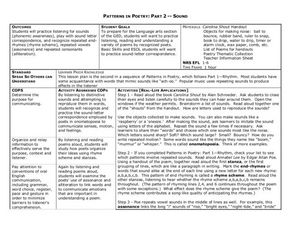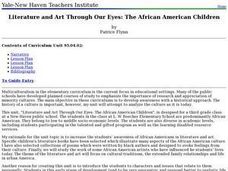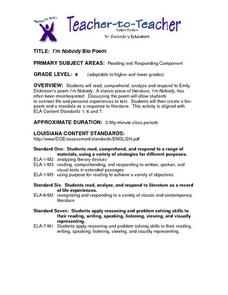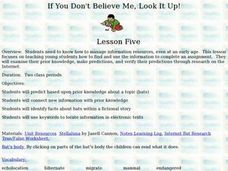Curated OER
Forming Open-Ended Questions
Help readers learn to create their own open-ended questions for any text you are working with. Using Bloom's Taxonomy, learners begin on the lower levels and work their way up to form questions that focus on synthesis instead of simple...
Curated OER
Poetry
Students apply reading comprehension skills to poetry and synthesize the information to create a new piece of work.
Curated OER
The Life And Death of Tupac Shakur
For this reading comprehension worksheet about Tupac Shakur, students read a short article about his life and death. Students answer 5 questions. There are mature themes in this article.
Curated OER
Regents High School Examination Comprehensive Examination in English Session Two (2008)
In this Regents High School Comprehensive Examination worksheet, students read a poem and an excerpt from an autobiography and answer comprehension questions. Students then write a unified essay based on both passages.
Curated OER
Regents High School Comprehensive Examination in English Session Two (2005)
Int this Regents High School English Comprehensive Examination young scholars read passages from a short story and a poem and write an essay based on both passages.
Curated OER
Rain
First graders practice oral and silent reading using beginning comprehension and decoding strategies. In this guided reading instructional activity, 1st graders take a picture walk and make plot predictions prior to reading the...
Curated OER
Rhythm & Improv: Jazz & Poetry
Students analyze the elements of poetry and jazz. In this critical thinking skills lesson, students take a closer look at the rhyme, rhythm, alliteration, form, free verse, lyricism, and imagery that exist is jazz as well as poetry.
Pennsylvania Department of Education
Drawing Conclusions Based on Literary Elements
Students compare versions of Cinderella and draw conclusions based on the story elements identified. In this literacy comprehension and story elements lesson, students read several versions of Cinderella, complete a "Comparing Folklore"...
Curated OER
Thanksgving Poem
First graders read a Thanksgiving poem to build reading comprehension skills. They develop the skill of using context clues while explaining the meaning of each line of the poem. The assessment is done as the teacher listens to poems...
Curated OER
Patterns in Poetry: Part 2 -- Sound
Students understand a variety of poems listening for sound letter correspondence, rhyme scheme, assonance, and alliteration. In this language arts instructional activity, students practice listening and reading skills to complete...
Curated OER
Letters to Poets
Add a strong poetry lesson to your literature unit. Middle and high schoolers investigate their writing voices with journaling and group discussion, then choose a famous poet to study. They write letters to their chosen poets, explaining...
Curated OER
Literature and Art Through Our Eyes: African-American Artists
Examine the contributions of African-Americans in the worlds of art and literature. Over the course of a few days, young scholars will read and analyze a poem, a short story, and a piece of art. They complete a range of...
Curated OER
Geography and Culture of China
Take out a map, a paper, a ruler, and those coveted colored pencils for a lesson on Chinese culture and geography. This is a multifaceted approach to basic geography skills that incorporate story telling, class discussion, primary source...
Curated OER
Magazine Production
Analyze magazines as a class, looking carefully for the target audience, advertisements, and topics presented. Small groups then work as a publication team and receive a magazine that they have to "sell." Each individual has a different...
Clark County School District
Owl Moon by Jane Yolen
A thorough lesson plan takes your first grade class through Jane Yolen's beautiful Owl Moon. It crafts the unit with clear objectives, high-level guiding questions, cloze activities and sentence frames, and extension...
Curated OER
Poetry to the Core
Second graders examine several examples of poetry in the six lessons of this unit. The lessons focus on five poetic forms, couplets, quatrains, limericks, Haiku, and free verse.
Curated OER
I'm Nobody Bio Poem
Eighth graders analyze Emily Dickinson's poem, I'm Nobody. After discussing it, they create their own bio poem. They draw and label mandalas and display them in class.
Curated OER
Signing a Poem
Pupils interpret poetry though movement. In this poetry activity students take a poem they've previously read and discussed in class and work in pairs to develop gestures for each line.
Curated OER
Analyzing Poetry and Characters
Students investigate historical context by reading poetry. In this language arts lesson, students discover the work of Michael Longley and examine his poem "Ceasefire." Students identify the sonnets used in the piece and...
Curated OER
Parts of a Story
Students read a short fiction book and demostrate comprehension by identifying the main characters, setting, conflict, theme, and summarizing the main points. They organize the information in Inspiration and create a powerpoint to show...
Curated OER
If You Don't Believe Me, Look It Up!
Students learn about bats. In this bats and comprehension lesson, students read Stellaluna and share what they know about bats. Students complete a learning log and Internet bat research worksheet.
Curated OER
The Power of Dialect
Students explore the power of dialect in poetry. In this poetry lesson, students listen to a reading of "In-a Brixtan Markit" while viewing the poem. Students rewrite the poem in English or using another dialect; or write...
Curated OER
Letter L
Students will have fun learning about the letter "L" with the activities in this lesson plan. The author suggests reading "Lightning Bug" from the McGraw-Hill reading book. However, you may find other poems that are fitting for this...
Curated OER
This Isn't Your Little Sister's Poetry: Analyzing and Understanding a Variety of Acclaimed Poets
Eleventh graders are introduced to various basic and advanced poetic devices. They read several poems and practice identifying poetic elements. They identify at least two different poems and substantiate why they belong in the canon.























